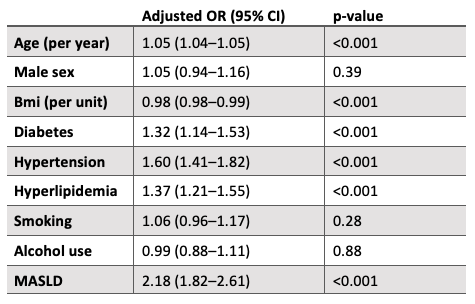Sunday Poster Session
Category: Liver
P1531 - Colorectal Cancer Risk in MASLD: Evaluating Independent and Interactive Effects of Metabolic Traits
Sunday, October 26, 2025
3:30 PM - 7:00 PM PDT
Location: Exhibit Hall
- VB
Viknesh Baskar, BA
SUNY Downstate Health Sciences University
Brooklyn, NY
Presenting Author(s)
Viknesh Baskar, BA1, Sushil K. Ahlawat, MD2
1SUNY Downstate Health Sciences University, Brooklyn, NY; 2SUNY Downstate Medical Center, Brooklyn, NY
Introduction: As metabolic dysfunction-associated steatotic liver disease (MASLD) becomes the most common liver disease worldwide, its extrahepatic consequences are increasingly under investigation. While colorectal cancer (CRC) is a leading cause of cancer-related morbidity and mortality, the potential link between MASLD and CRC, particularly in the context of co-existing metabolic conditions, remains unclear. This study evaluates whether MASLD is independently associated with CRC and explores whether individual metabolic traits modify this association.
Methods: This retrospective cohort analysis was conducted using the All of Us Research Program Dataset version 7, which includes both inpatient and outpatient records from a diverse, U.S.-based population. Adults with MASLD were identified using ICD-10 codes, excluding those with other chronic liver conditions. Controls had no recorded liver disease diagnoses. Logistic regression was used to assess the association between MASLD and CRC, adjusting for age, sex, BMI, diabetes, hypertension, hyperlipidemia, smoking, and alcohol use. Interaction terms between MASLD and metabolic traits (diabetes, hypertension, hyperlipidemia, obesity) were included to test for effect modification.
Results: We included 10,057 participants with MASLD and 313,151 matched controls. In the multivariable analysis, MASLD was independently associated with increased odds of CRC (OR 2.18, 95% CI 1.82–2.61, p < 0.001). Increasing age, diabetes, hypertension, and hyperlipidemia were independently associated with higher CRC risk (all p < 0.001), while smoking and alcohol use were not significant. No significant interaction was observed between MASLD and any individual metabolic trait, including diabetes (p = 0.31), hypertension (p = 0.66), hyperlipidemia (p = 0.84), or obesity (p = 0.89), indicating these conditions did not modify the strength of the MASLD–CRC association.
Discussion: MASLD is associated with increased odds of CRC, independent of traditional metabolic risk factors. The absence of significant interaction effects suggests that MASLD confers CRC risk regardless of co-existing metabolic conditions. While metabolic traits such as diabetes, hypertension, and hyperlipidemia were independently associated with CRC, they did not significantly modify the association between MASLD and CRC. These findings support considering MASLD as a standalone CRC risk factor, highlighting the need to consider MASLD status in CRC risk models and future screening guidelines.

Figure: Table 1. Association Between MASLD and Colorectal Cancer in Multivariable Logistic Regression

Figure: Table 2. Interaction Between MASLD and Metabolic Traits in Relation to Colorectal Cancer Risk
Disclosures:
Viknesh Baskar indicated no relevant financial relationships.
Sushil Ahlawat indicated no relevant financial relationships.
Viknesh Baskar, BA1, Sushil K. Ahlawat, MD2. P1531 - Colorectal Cancer Risk in MASLD: Evaluating Independent and Interactive Effects of Metabolic Traits, ACG 2025 Annual Scientific Meeting Abstracts. Phoenix, AZ: American College of Gastroenterology.
1SUNY Downstate Health Sciences University, Brooklyn, NY; 2SUNY Downstate Medical Center, Brooklyn, NY
Introduction: As metabolic dysfunction-associated steatotic liver disease (MASLD) becomes the most common liver disease worldwide, its extrahepatic consequences are increasingly under investigation. While colorectal cancer (CRC) is a leading cause of cancer-related morbidity and mortality, the potential link between MASLD and CRC, particularly in the context of co-existing metabolic conditions, remains unclear. This study evaluates whether MASLD is independently associated with CRC and explores whether individual metabolic traits modify this association.
Methods: This retrospective cohort analysis was conducted using the All of Us Research Program Dataset version 7, which includes both inpatient and outpatient records from a diverse, U.S.-based population. Adults with MASLD were identified using ICD-10 codes, excluding those with other chronic liver conditions. Controls had no recorded liver disease diagnoses. Logistic regression was used to assess the association between MASLD and CRC, adjusting for age, sex, BMI, diabetes, hypertension, hyperlipidemia, smoking, and alcohol use. Interaction terms between MASLD and metabolic traits (diabetes, hypertension, hyperlipidemia, obesity) were included to test for effect modification.
Results: We included 10,057 participants with MASLD and 313,151 matched controls. In the multivariable analysis, MASLD was independently associated with increased odds of CRC (OR 2.18, 95% CI 1.82–2.61, p < 0.001). Increasing age, diabetes, hypertension, and hyperlipidemia were independently associated with higher CRC risk (all p < 0.001), while smoking and alcohol use were not significant. No significant interaction was observed between MASLD and any individual metabolic trait, including diabetes (p = 0.31), hypertension (p = 0.66), hyperlipidemia (p = 0.84), or obesity (p = 0.89), indicating these conditions did not modify the strength of the MASLD–CRC association.
Discussion: MASLD is associated with increased odds of CRC, independent of traditional metabolic risk factors. The absence of significant interaction effects suggests that MASLD confers CRC risk regardless of co-existing metabolic conditions. While metabolic traits such as diabetes, hypertension, and hyperlipidemia were independently associated with CRC, they did not significantly modify the association between MASLD and CRC. These findings support considering MASLD as a standalone CRC risk factor, highlighting the need to consider MASLD status in CRC risk models and future screening guidelines.

Figure: Table 1. Association Between MASLD and Colorectal Cancer in Multivariable Logistic Regression

Figure: Table 2. Interaction Between MASLD and Metabolic Traits in Relation to Colorectal Cancer Risk
Disclosures:
Viknesh Baskar indicated no relevant financial relationships.
Sushil Ahlawat indicated no relevant financial relationships.
Viknesh Baskar, BA1, Sushil K. Ahlawat, MD2. P1531 - Colorectal Cancer Risk in MASLD: Evaluating Independent and Interactive Effects of Metabolic Traits, ACG 2025 Annual Scientific Meeting Abstracts. Phoenix, AZ: American College of Gastroenterology.
